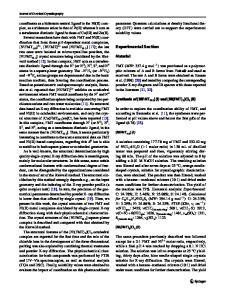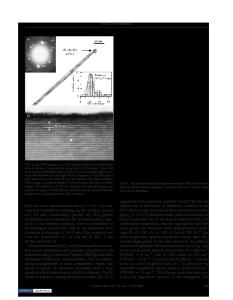Synthesis, Characterization, and Crystal Structure of ( E )-4-(2-(4-Cyanobenzylidene)hydrazinyl)benzonitrile Dimethyl Su
- PDF / 544,283 Bytes
- 4 Pages / 612 x 792 pts (letter) Page_size
- 3 Downloads / 259 Views
TRUCTURE OF ORGANIC COMPOUNDS
Synthesis, Characterization, and Crystal Structure of (E)-4-(2-(4-Cyanobenzylidene)hydrazinyl)benzonitrile Dimethyl Sulfoxide Hemisolvate V. Sharmaa, I. Karmakarb, G. Brahmacharib, and V. K. Guptaa,* a b Laboratory
Department of Physics, University of Jammu, Jammu-Tawi, India
of Natural Products and Organic Synthesis, Department of Chemistry, Visva-Bharati (a Central University), Santiniketan, West Bengal, 731235 India *e-mail: [email protected] Received January 21, 2019; revised February 20, 2019; accepted March 26, 2019
Abstract—(E)-4-(2-(4-Cyanobenzylidene)hydrazinyl)benzonitrile dimethyl sulfoxide hemisolvate, C15H10N4 ⋅ 0.5C2H6OS is synthesized following a green protocol and its crystal structure is determined by X-ray structure analysis. The crystals are monoclinic, sp. gr. C2/c, Z = 4. Two benzonitrile moieties forms a dihedral angle of 7.62° with each other. The crystal structure is stabilized by N–H⋅⋅⋅O hydrogen bond involving the DMSO solvate molecule.
DOI: 10.1134/S1063774520070160
INTRODUCTION
EXPERIMENTAL
Hydrazone derivatives bearing an azomethine (‒NHN=CH–) moiety represent an important class of pharmacologically useful compounds with varying applications in the field of microbial infections, inflammations, tuberculosis, hypertension, cancerous diseases and many more [1–6]. In compliance with such potential applications of hydrazones, medicinal chemists have been deeply devoted in exploring diverse hydrazone derivatives with better activity and low toxicity profiles. In present communication, we describe green synthetic protocol for the preparation of a new hydrazone derivative, (E)-4-(2-(4-cyanobenzylidene)hydrazinyl)benzonitrile (3) in aqueous medium at room temperature (Fig. 1), and its detailed spectral and X-ray crystallographic studies.
General
H N
CHO + NC
NH2
NC
4-Formylebenzonitrile 4-Hydrazinylbenzonitrile (1; 1 mmol) (2; 1 mmol)
Infrared spectra were recorded on a Shimadzu (FT-IR 8400S) FT-IR spectrophotometer using KBr disc. 1H and 13C NMR spectra were obtained at 400 and 100 MHz, respectively, using a Bruker DRX-400 spectrometer and DMSO-d6 as the solvent. Elemental analyses were performed with an Elementar Vario EL III Carlo Erba 1108 microanalyzer instrument. The melting point was recorded on a Chemiline CL-725 melting point apparatus and is uncorrected. Thin layer chromatography (TLC) was performed using silica gel 60 F254 (Merck) plates. X-ray diffraction intensity data were recorded on X’calibur CCD area-detector diffractometer.
Anthranilic acid (10 mol %) H2O (4 mL) stirring at room temperature (rt; 25‒28qC) for 5 min (no column chromatography)
N
H N
NC
(E)-4-(2-(4-Cyanobenzylidene) hydrazinyl)benzonitrile 3
Fig. 1. Chemical scheme showing the synthesis of (E)-4-(2-(4-cyanobenzylidene) hydrazinyl)benzonitrile (3).
1191
CN
1192
SHARMA et al.
Table 1. Crystallographic characteristics and the X-raydata collection and structure-refinement parameters for C15H10N4 ⋅ 0.5C2H6OS System, sp. gr., Z a, b, c Å β, deg V, Å3 Dx, g cm–
Data Loading...











